Expert’s Rating
Pros
- Comfortable to wear
- Plenty of health tracking features
- Wide range of straps to personalise device
Cons
- Tracking isn’t always super-accurate
- No NFC
- No GPS
Our Verdict
A solid budget fitness tracker with plenty of features. The accuracy is sometimes a bit off, but as a general guide to your health and fitness it’s one of the best around.
Price When Reviewed
$49.99
Best Prices Today: Xiaomi Smart Band 8
$47
Chinese giant Xiaomi returns with the latest iteration of its Smart Band series, but does this new generation fitness tracker have what it takes to compete with the impressive range of other inexpensive wearables that consumers can choose between these days?
I lace up my trainers and take the Xiaomi Smart Band 8 out for some exercise.
Design & Build
- Lightweight and comfortable
- 5ATM water resistance
- Wide range of bands available
The design of the Smart Band 8 doesn’t depart too much from those we’ve generally seen with fitness trackers over the past few years. The unit itself is a pill-shaped metal frame that measures 48mm x 22.5mm x 10.99mm and weighs 27g, all of which means it sits comfortably on the wrist.
The front is home to the 1.62-inch AMOLED display, while the rear has various sensors, which comprise the PPG heart rate, Ambient light, and 6-axis sensor, as well as the charging port.
There are no buttons or speaker grills, which helps the unit attain a water resistance for up to 5TM (down to depths of 50 metres for around 10 minutes), so you can safely take it swimming and diving.
This time around, Xiaomi has gone all in on the straps and fittings, giving the Band 8 the Apple Watch treatment.
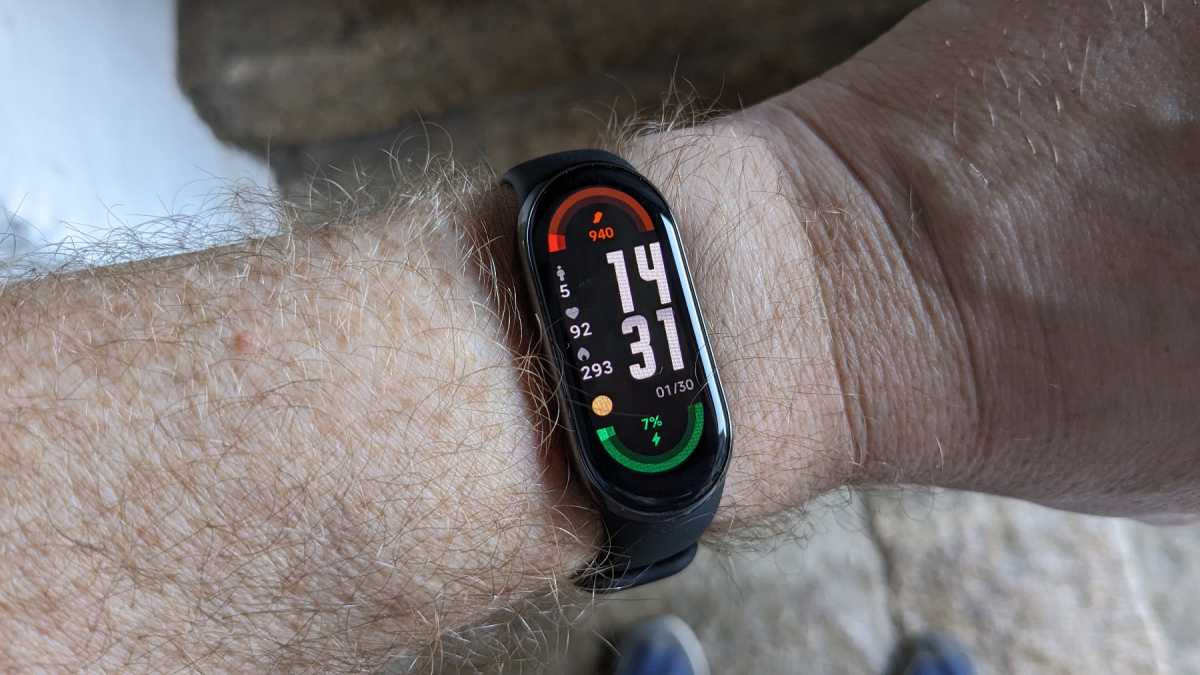
Martyn Casserly
The two main models are Gold and Black (which pertains to the surrounding colour of the tracker’s metal frame) and you get either black or white TPU straps that will fit wrists from 135–210mm. This time around, Xiaomi has gone all in on the straps and fittings, giving the Band 8 the Apple Watch treatment.
Via the Mi store you can purchase a wide variety of bands, including calf leather, double wrap-around, leather and metal chain straps, plus a selection of brighter coloured TPU ones if you want to keep things sporty.
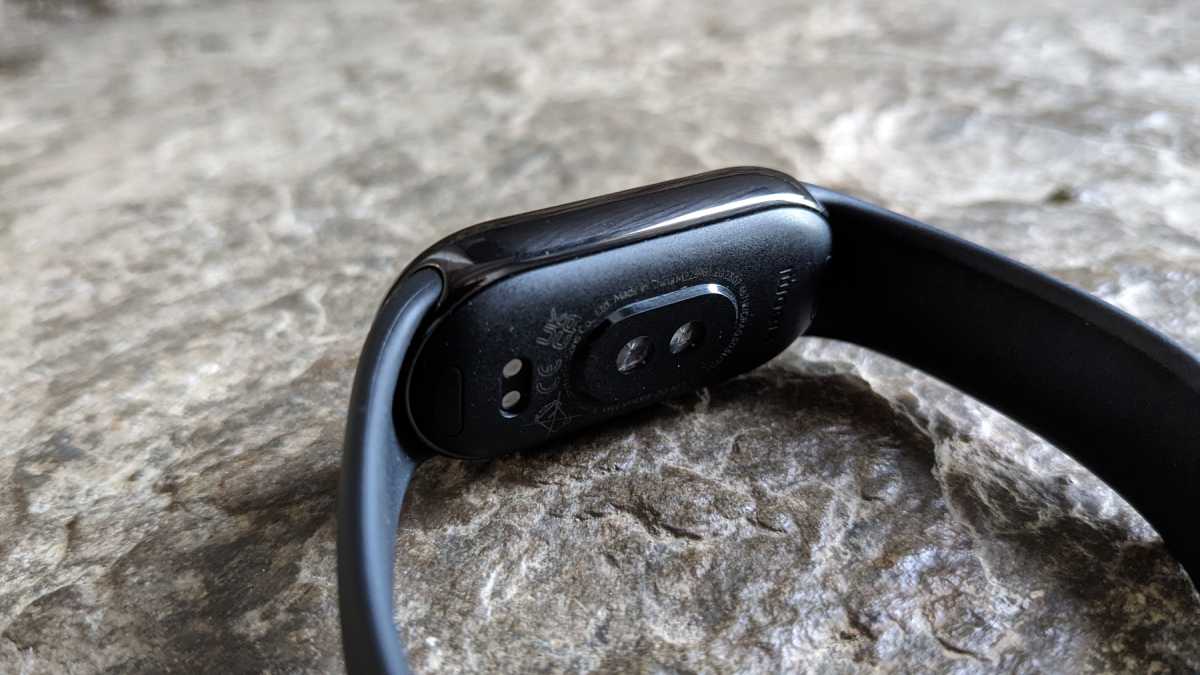
Martyn Casserly
There’s also a pendant clip, so you can wear the tracker on a necklace. This might seem a bit like a nurse from the 70s, but you’ll still get notifications, a step count (albeit not as accurate as on the wrist) and other smart features. Another option is a clip that you can use to attach the Band 8 to the laces of your trainers. Coupling this with the dedicated running tracking in the Mi Fitness app and you’ll get a decent level of information on your performance.
It’s unusual to see fitness trackers being given such a wide range of style choices, as this sort of thing is usually reserved for smart watches. But I think it’s a clever move by Xiaomi, as it allows people to personalise their device. This is all made more appealing by the fact that the straps range in price from £6.99 ($8.89) to £24.99 ($31.70), avoiding some of the outrageous prices companies like Apple ask for theirs.
It should be noted that the previous Band 7 straps won’t work with the new fitting on the Band 8, so if you’re upgrading and thinking of bringing your old straps with you, you’ll be out of luck this time around.
Display
- 1.62inch AMOLED display
- 60Hz refresh rate
- Always-On feature
The display now features a 60Hz refresh rate, it was 30Hz on the Xiaomi Mi Band 7, which does make the scrolling on it look smoother than on pretty much all the fitness trackers, and even some smart watches, I’ve reviewed in the past. It can also reach a maximum brightness of 600 nits, 100 more than the previous model, although I will admit I did struggle to read the information displayed on it when in strong sunlight.
As you’d expect, the 1.62inch AMOLED panel looks great, with strong colours and clear text on offer thanks to the 192 x 490 resolution. Touch sensitivity is ok, but the display didn’t always recognise taps to confirm changes to settings. This could be due to Xiaomi not wanting the device to accidentally mistake stray touches and taps as commands. It wasn’t a big problem, as the menu lets you know when you’ve activated or disabled something, so you at least always knew if the response was there or not.

Martyn Casserly
Xiaomi says the display is made from 2.5D reinforced glass, which is a material used on several cheaper devices, presumably to keep down costs. It’s fair to say that it probably won’t be as hardy as something like Gorilla Glass, but it seemed robust enough for the time I spent testing the Band 8, with no apparent scratches to be found on the surface.
There’s an auto-brightness built-in and you can also activate the Always-on feature if you want the Band 8 to act as a form of wrist watch. This will cost you battery-life, but the Band already performs admirably in this area, so it shouldn’t feel like a big deal.
As with the straps, there are plenty of alternative watchfaces available for free in the app, and many of them are well designed, so you should be able to make the Xiaomi Band 8 feel personalised to you while also getting the data you want.
Software & Features
- Easy to use menus
- Plenty of built-in apps
- Works with music, podcast and audiobook apps
The interface on the Xiaomi Smart Band 8 is very much on par with its predecessors and other trackers on the market. The home screen can be changed via the different watch faces mentioned above, with the information shown varying. On some you will be able to have instant access to your steps, heart rate, calories burned, time, date and remaining charge or a smaller selection of these metrics.
Navigation is controlled by swiping left, right, up or down. From the home page you can swipe left or right to cycle through the quick settings and other apps that you can set up in the Mi Fitness app. Up opens up the app menu where you can kick off workouts, test your heart rate or plenty of other features. Swiping down opens up the notifications area. Xiaomi doesn’t include a home button, so you’ll need to swipe back to the page you want, which can be a little tiresome, but the pages are not too deep so you quickly get used to nipping around the interface.

Martyn Casserly
You do now have the option to set the right swipe to open up a page where you can have quick links to two apps, which should make it easier to access the ones you use most.
Aside from the health-related features, which I’ll cover below, you get some additional tools to use. The Xiaomi Smart Band 8 is compatible with music and audio apps, so you can control the playback and volume without having to use your phone. There’s also a weather app (fed by the Mi Fitness app), torch, stopwatch, alarms, events (although this can’t pick up ones in your existing calendar), as well as controls for your phone that include enabling silent mode, a remote control for the camera, and a find my phone option that causes your handset to ring.
You get notifications of messages that you’ve received, but you won’t be able to reply. It’s a different case with phone calls, as you can reject them if you’re busy, but fire off a preset message, such as ‘In a meeting, I’ll call you later’.
Connectivity is handled by Bluetooth 5.1 BLE, which pairs it with your phone and the Mi Fitness app, all of which syncs well. Sadly the lack of GPS or NFC means you won’t be able to directly track your exercise routes or make payments with the Band 8, but this isn’t unusual for a device in this price range.
Health & Fitness Tracking
- Over 150 fitness modes
- Heart, SpO2, steps, stress and sleep monitoring
- Fitness tracking is adequate
Most people buy fitness trackers to keep an eye on their health as well as a way to get more information on their exercise. In these areas the Xiaomi Band 8 is an excellent companion, considering the price.
For everyday health, the device can monitor your heart-rate at intervals of 1-, 10- or 30 minutes, with the option to set up thresholds for low or high BPMs that trigger notifications to warn you that you’ve hit these limits.
The sleep tracking is arguably more useful than on something like the Apple Watch
In comparison to some other trackers and smartwatches I have, the monitoring did seem a little wayward at times, but would still be a good tool for getting a general picture of your heart health – this isn’t a highend professional running watch after all.
You can also avail yourself of the blood oxygen (SpO2) monitor, as well as another for stress, both of which are best treated as rough guides rather than precision medical trackers.
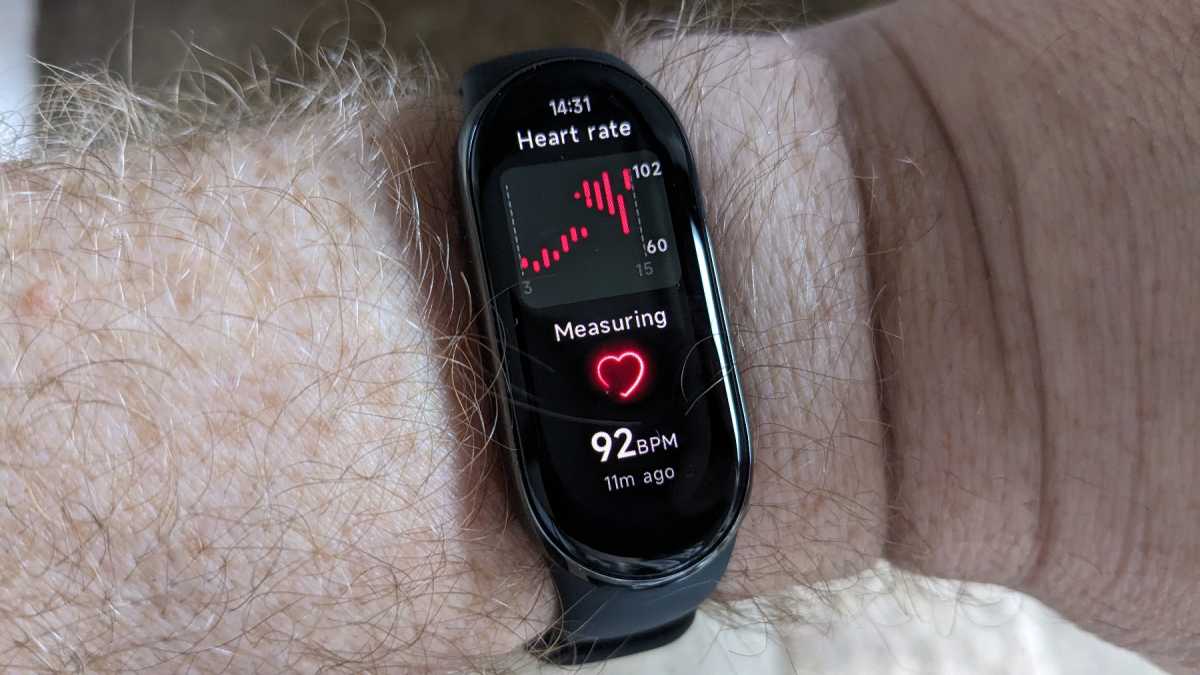
Martyn Casserly
The sleep tracking is arguably more useful than on something like the Apple Watch, which often needs to be charging overnight and therefore not great for monitoring your sleep from your bedside table.
Each morning you get a map of the night’s sleep, with sections for deep, REM, and light phases. You’ll also be informed of when you went to bed and got up, plus any waking instances in the night.
There’s also the option to enable breathing monitoring too, although I’m not really sure how this actually works in terms of tracking capability.
Again, this all allows you to build up an awareness of how your sleep routine is working, with probably more focus on the times of sleep being the most accurate, as there’s no real way to know if the other metrics are on the money or not as you’re unconscious when they’re happening.
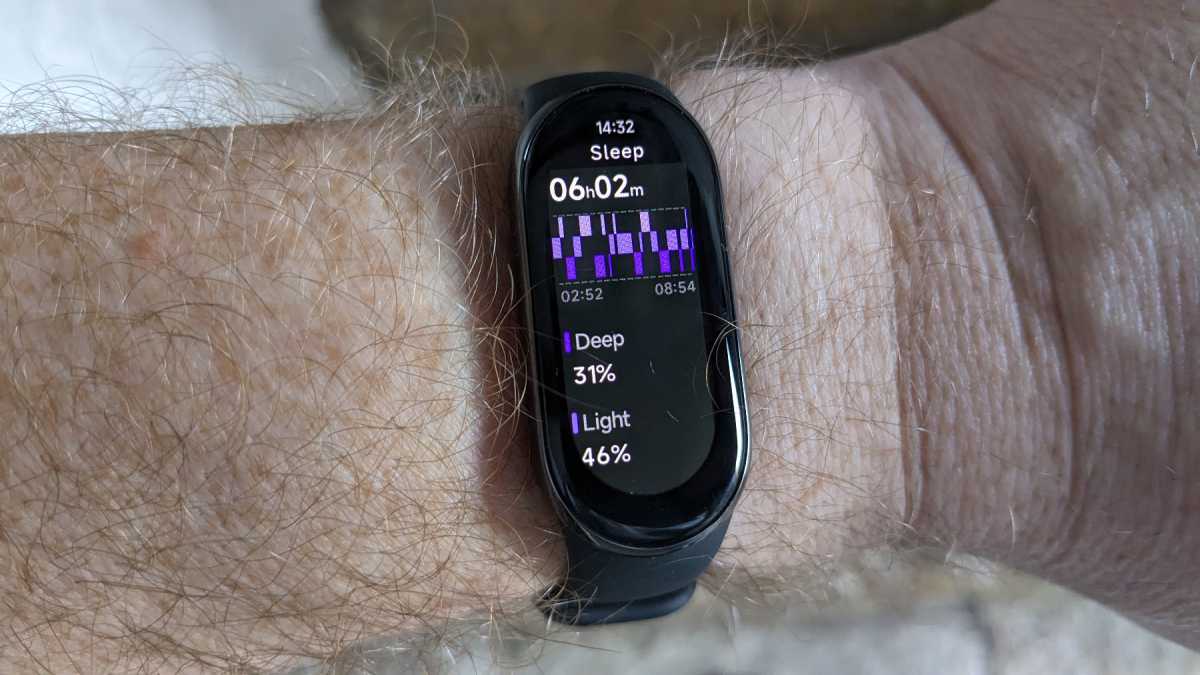
Martyn Casserly
Xiaomi packs the Smart Band 8 with specialised tracking modes for over 150 different activities. These range from normal exercise like walking, running, cycling, swimming and aerobics, to more exotic (and slightly questionable) athletic events such as Dragon boat racing, snowmobile riding, and chess. Yes, chess. Or there’s checkers if you’re feeling more energetic.
Fair to say, I’d wager many of the modes do exactly the same thing, but with the main gym and track based ones covered, you’ll be able to monitor your fitness training well with the Band 8. The lack of GPS does mean that you can’t track any routes for runs, walks, cycles rides or hikes without your phone.
You’ll also need to remember to either enable the auto-sensing of workouts, which can be hit and miss, or manually start the tracker at the beginning of a session.
The former is definitely preferable if you’re a forgetful old sod like me. After a good swimming session to test the waterproof nature of the Smart Band 8 (it was great) as well as the tracking, I finished and realised I hadn’t engaged the tracking and instead was told I’d walked around a bit instead.
When engaged properly, I found the tracking to be decent, with the device sensing different levels of activity and stress throughout the session. These include average pace, recovery time, light, intense, VO2, aerobic and anaerobic. You get a breakdown of the metrics on the Band, but for a more comprehensive record the data is synced to the Mi Fitness app (which replaces the previous Zepp app).
There’s also a scores for Training Effort, which lets you know how hard you’ve pushed yourself, with a Vitality score that awards points across the week to help motivate you to get out and exercise.
The Mi Fitness app is a good accompaniment to the Band 8, offering the ability to view your progress, fine tune which health metrics you want the Band to track in more depth, plus a range of other settings for messages and other apps which would be a bit tricky to control directly from the app. If you’re interested in digging into your health data, then expect to spend some time in the Mi Fitness app, which should be no bad thing.
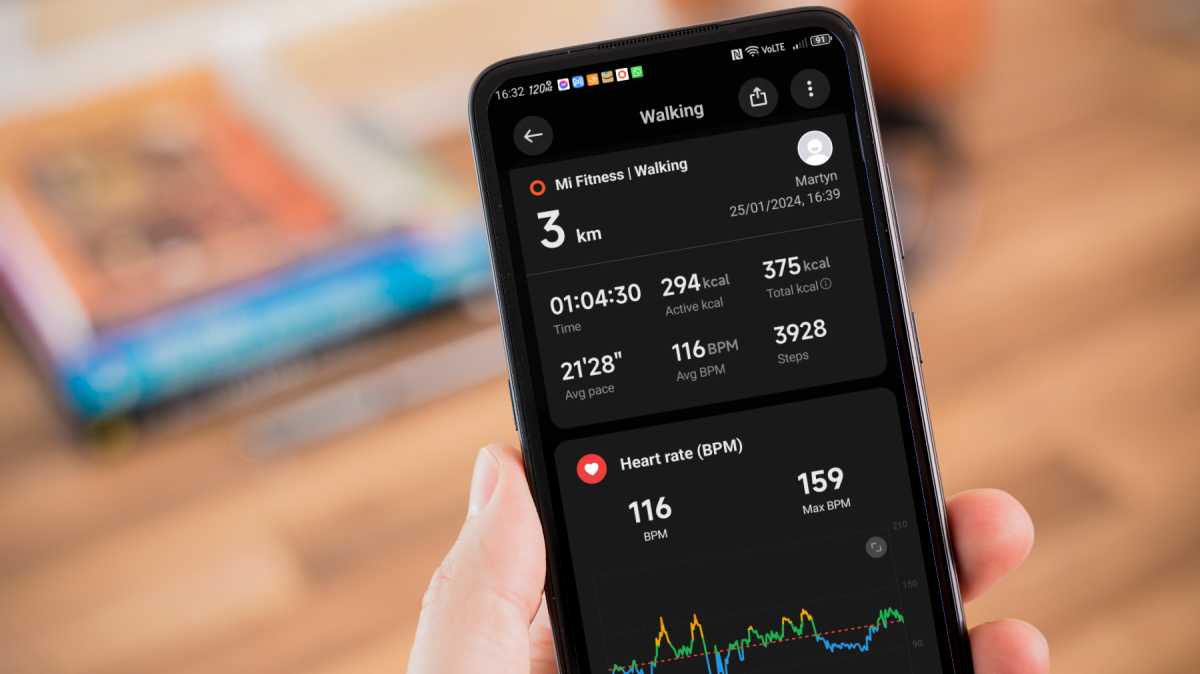
Martyn Casserly
One potential downside is that many of the tracking features are disabled on the device by default. So it takes a little while to get things properly up and running as you slowly realise which bits are not recording and then fix that by enabling the feature.
I also ran into a few instances where the app didn’t track locations or data, even though the feature was enabled. But, hopefully, this will be fixed in future updates.
Battery Life & Charging
- 190mAh battery
- Impressive longevity
- Reasonably quick recharge times
One of the best…
